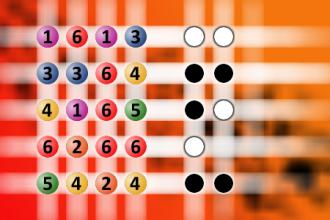Which is a winning combination of digits?
The computer chose a secret code (sequence of 4 digits from 1 to 6). Your goal is to find that code. Black circles indicate the number of hits on the right spot. White circles indicate the number of hits on the wrong spot.Correct answers: 27
The first user who solved this task is Djordje Timotijevic.
#brainteasers #mastermind

Demetri Martin: Rock, Paper, Scissors
I like rock, paper, scissors -- two-thirds. Rock breaks scissors: these scissors are bent, theyre destroyed, I cant cut stuff -- I lose. Scissor cuts paper: this is strips, this is not even paper, this can take me forever to put this back together -- you got me. Paper covers rock: rock is fine, no structural damage to rock. Rock can break through paper at any point, just say the word. Paper sucks. It should be rock, dynamite with a cuttable wick, scissors.

